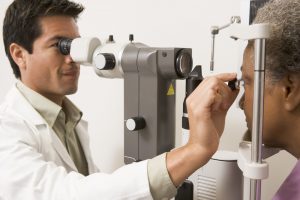March has been designated as Workplace Eye Wellness Month by both the American Academy of Ophthalmology and Prevent Blindness, a non-profit organization. At Minnesota Eye Consultants, we want all our patients to understand how to protect their eyes at work.
Many people don’t realize that there are risks to your vision in any industry – whether you are doing industrial work, medical care or working at a computer in an office.
Protect Yourself from Traumatic Eye Injury

The CDC estimates that nearly 2,000 people experience eye injuries every day at work in the US. And each year, about 25,000 people visit Emergency Departments for work-related eye injuries.
Many suffer permanent vision damage or even blindness. However, a good portion of these injuries could be prevented if the victims had received adequate safety training and/or utilized proper eye safety equipment.
Workers in industries such as construction, manufacturing, auto repair, landscaping, and animal care are at especially high risk for work-related eye injuries. Those injuries generally fall into five categories:
- Striking or scraping the eye by small particles or objects, such as dust, cement, drywall, or wood chips. Even what looks like a minor scratch can cause recurrent discomfort from a corneal abrasion.
- Blunt force trauma from large objects striking the eye or face, or bumping into objects or corners.
- Penetration from nails, staples, or slivers of wood or metal.
- Chemical burns from wet cement, industrial chemicals or cleaning products.
- Thermal burns or UV exposure, primarily from welding.
Employers should assess the work environment for potential safety hazards and provide safety training at least once per year.
The best way to protect yourself from a traumatic eye injury is by wearing protective eyewear that fits properly. Depending on your specific job, you may need goggles, safety glasses, a welding helmet, a full-face respirator or a face shield. The use of protective eyewear marked Z87 is required for some occupations. Z87+ provides the added protection of impact-resistant polycarbonate lenses.
If you work in a high-risk industry, there are other simple work habits that could provide increased protection for your eyes. Clean your eyewear regularly. Never rub your eyes with dirty hands or clothing. Before you remove any safety glasses, goggles, or masks, remember to brush or shake off the dust from your hardhat, hair, or the top of the protective goggles themselves.
What Should You Do If You Get Hurt?

If you experience a workplace eye emergency, it is important to act immediately and see a doctor as soon as possible. No matter what type of damage you experience, remember to never rub the eye, as it could cause further harm.
Many employers have an eyewash or sterile solution available for rinsing the eye. If there is a foreign object stuck in your eye, do not try to remove it yourself! Call 911 or get a ride to the closest Emergency Department.
Exposure to Infectious Diseases

Health care workers and first responders such as police, fire, and rescue workers can be at risk for splashes of blood and bodily fluids getting into the eye. Most people in these jobs have been trained in “universal precautions” to help prevent transmission of infectious diseases, but some do not practice these precautions regularly.
Whenever possible, it’s advisable to wear safety glasses or clear masks. If you do experience a splash in the eye, rinse it immediately. Seek medical advice regarding follow-up care.
Computer Vision Syndrome

People who work with computers, tablets, and other electronic devices all day have a different type of eye health risk: computer vision syndrome (also known as digital eye strain). It causes symptoms such as blurriness, double vision, dry/red eyes, and general discomfort and irritation.
While there is no proof that computer use causes permanent eye damage, these uncomfortable symptoms can interfere with your work performance and how you enjoy your life.
Here are some simple steps that may help prevent or decrease the symptoms of computer vision syndrome:
- Sit 25-30 inches away from your computer screen. Your monitor should be slightly below eye level.
- Reduce glare by adjusting the light in your workplace. Move your computer screen to be at a right angle from any direct light source. If there is glare from a nearby window, lower the shade, if possible. Try a desk lamp that spreads light evenly over your work surface. Adding a filter to your monitor can also reduce glare.
- Use the 20-20-20 rule: every 20 minutes you should look at an object at least 20 feet away for 20 seconds or more. It is also helpful to take a 10 to 15-minute break and walk away from your computer every two hours.
- Change your computer settings by adjusting the brightness, contrast and font size. Pre-installed computer settings don’t always work for everyone.
- Blink your eyes frequently to keep them from getting dried out. We blink about 15 to 20 times a minute, which spreads tears over the eyes and keeps them moist. Research has shown that people blink less than half as often when they are working in front of monitors or devices.
- Use artificial tears (over-the-counter moisturizing eye drops) to help prevent dry eye and keep your eyes comfortable.
- If you normally wear contact lenses, give your eyes a break by wearing glasses.
- Keep your eyes moist by staying hydrated. During the colder months, environmental heat makes the air very dry and increases eye irritation. Room humidifiers are beneficial in reducing the effects of a dry environment.
Get Your Eyes Checked!

Make an appointment with your doctor at Minnesota Eye Consultants if you are having any problems with your eyes. If you work in front of a computer and are showing signs of computer vision syndrome, you may need a new prescription.
You may also need special glasses for computer work. Some people benefit from tinted lens material that boosts contrast and filters out glare.
Have more questions about how you can keep your eyes protected in the workplace? Schedule an appointment at Minnesota Eye Consultants in Minneapolis, MN!









